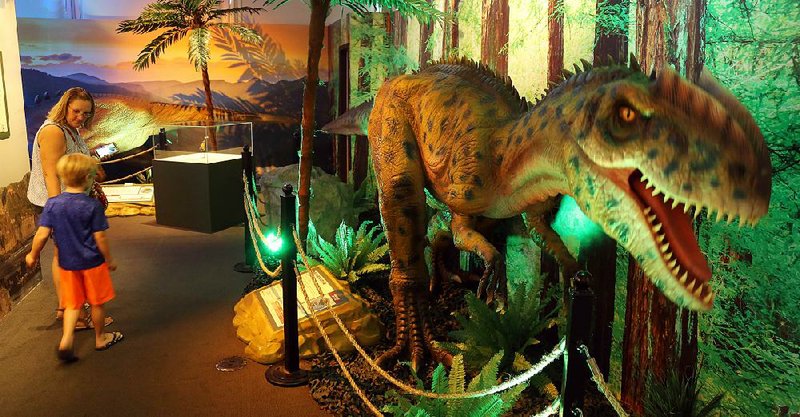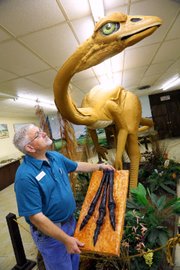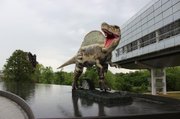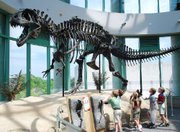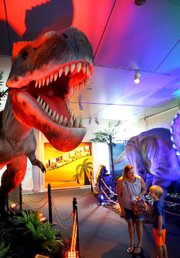Dinosaurs are taking a big bite out of summer.
"Anything Jurassic is very popular right now," says Jim Miller, spokesman for the Mid-America Science Museum in Hot Springs.
The dinosaur movie Jurassic World is the T. rex in the room, with its reported $150 million behemoth of a production budget (plus another estimated $150 million in marketing). Or as dinosaur-keeper Chris Pratt says in the box office record-breaking film, "They're dinosaurs. 'Wow' enough."
The animatronic exhibit "Dinosaurs Around the World" continues through Oct. 18 at the Clinton Presidential Center in Little Rock. The show's 13 life-like saurians include a rearing, roaring Tyrannosaurus.
The Hot Springs museum's Dino Dig exhibit is a challenge to find fossils, and "we also, of course, have our Sauropod footprint display," Miller says.
The Howard County city of Nashville holds an annual spring Dinosaur Festival to celebrate the discovery of just such tracks near town in 1983.
Weathered and mined away in the years since, the Nashville Sauropod trackway might have been a migration path for some of these long-necked plant-eaters. The discovery of a likewise-beaten path in southwest Arkansas brought a University of Arkansas team to the site in 2011.
The only dinosaur bones that have come to light in Arkansas are those of Arkansaurus fridayi, named for the state and the man who discovered them. J.B. Friday found the remains of the ostrich-like creature's right foot near Lockesburg in Sevier County in 1972.
A probable likeness of
Arkansaurus fridayi is on display at the Arkansas Geological Commission Learning Center in Little Rock.
Nothing more has been found of the creature, says Sandra Chandler, an educator with the state geological survey. No more dinosaur bones -- "bits and pieces, but nothing identifiable."
The Arkansas State Dinosaur website (arkansasstatedinosaur.weebly.com) and Facebook page petition for Arkansas to name Arkansaurus the official state dinosaur. Texas, after all, has one: the Paluxysaurus jonesi.
Arkansaurus' website is the creation of Fayetteville High School junior Mason "Cypress" Oury, who reports enlisting about 40 supporters. He is hoping for a gigantic response to impress the state's governor and general assembly.
"My goal is to get the state of Arkansas a state dinosaur," Oury says. "I feel that having a state dinosaur for Arkansas would be just about the coolest thing ever."
THE BIG CONTENDER
Arkansaurus fridayi lived 100 million years ago, according to the Arkansas Geological Survey.
Sea water spread from the Gulf of Mexico into Arkansas. Dinosaurs roamed along a shallow sea in the general area of today's Howard and Sevier counties.
Arkansaurus' foot bones suggest a likely resemblance to other dinosaurs that left the same type of track, according to the survey's report.
If so, Arkansaurus probably stood 6 to 15 feet high on its back legs, a "swift hunter" of small animals. It might have eaten bugs, eggs and leaves, besides. It might have had a bird-like beak, or maybe a carnivore's teeth.
The model is iffy, "like taking your foot and trying to figure out what the rest of you looks like," geology supervisor Bill Prior says. The work of cartographer Vance Pleasant nearly 25 years ago, the Styrofoam replica stands as a best guess, lacking more evidence -- ideally, the skull.
For now, Arkansaurus fridayi "is not officially recognized by the scientific community," Prior says. The creature might be unique to Arkansas. But it might as well turn out to be a species already studied, already named something else.
In any case, it came from the only spot in the state where a dinosaur bone is apt to turn up.
"The secret to being fossilized is that you've got to be buried," Prior says. Ocean water buries the past under layers of sediment.
Dinosaurs of many sorts might have trod the northern part of the state. But the dry land did nothing to save a record of their existence.
Along the southwest's patch of prehistoric shore line, a guy like Arkansaurus could hope to die in the mud -- and with any luck, sink deeper.
The earth rumbled. The water came and went. The sea left sand and clay in layers that buried the remains of Arkansas' dinosaur past.
THE BIG MISS
Acrothanosaurus is the state's nearest claim to a teeth-gnashing predator of the sort that snaps at tourists in Jurassic World, a sequel to Jurassic Park (1993).
The bones of this ravenous stomper turned up in McCurtain County, Okla., just across the state line from Sevier County in southwest Arkansas, in 1983. Texas author Russell Farrell's book, Acrocanthosaurus: Bones of Contention (Historical Dimensions), details the find by a self-proclaimed "Arkansas hillbilly," Cephis Hall.
No respecter of boundaries, Acrothanosaurus probably set foot in Arkansas, too.
Nicknamed Fran, the 13-foot-high skeleton menaces visitors to the North Carolina Museum of Natural History in Raleigh. A replica tagged "The McCurtain County Dinosaur" is on display at the Museum of the Red River in Idabel, Okla., about an hour's drive west from De Queen in Sevier County.
Fran was two tons of fast-moving saurian with 68 sharp teeth, but still, slightly smaller than Hollywood's favorite thunder lizard -- star of screen, video game, toy store and children's pajamas, the mighty Tyrannosaurus.
THE BIG SHOW
Celebrities don't come much bigger than this: Tyrannosaurus rex, king of the "Dinosaurs Around the World" show at the Clinton Presidential Center.
The 15-foot-tall animatronic saurian nearly scrapes the ceiling as he lifts his wrecking ball of a head, showing rows of monstrous teeth.
But the man who knows the most about dinosaurs in this room -- pretty much any room -- is hard to impress.
"The growly ones, I don't think much of," paleontologist Jack Horner said as he toured the show just before it opened. He doubts that even the meanest dinosaurs roared like lions.
Horner, from Montana State University, has been movie director Steven Spielberg's adviser on all the Jurassic Park movies, including Jurassic World. Actor Sam Neill's character in the earlier movies, Alan Grant, is partly based on Horner, complete to Horner's slouch-brimmed hat.
Horner pointed to a smaller specimen as more likely close to the real thing. The exhibit's Oviraptor (the name translates to "egg stealer") is an emu-size creature with feathers and a bird-like beak.
Rather than give out a rattling bellow, the Oviraptor goes "honk-honk-honk" over the stolen prize of a spotted egg.
"Like a goose," Horner says, advancing his contention that dinosaurs probably looked and sounded like their descendants, today's birds.
His book How to Build a Dinosaur: The New Science of Reverse Evolution (Plume, 2010) tells what it would take to "biochemically nudge" a chicken embryo, and so to hatch a dinosaur with teeth and claws from a chicken egg.
THE BIG STORY
"Dinosaurs Around the World" is the latest display from Imagine Exhibitions, headquartered in Atlanta.
The Clinton Center "is a great venue," company president Tom Zaller says, having made sure the exhibit points out the connection between dinosaurs and the 42nd president of the United States.
In 1996, Clinton set aside nearly 2 million fossil-strewn acres in Utah as Grand Staircase-Escalante National Monument. Displays include the replica of a dinosaur skull found there -- a duck-billed plant-eater with 800 teeth.
Two other dinosaurs greet visitors outside the presidential center, flanking the entrance. They move and growl, activated by motion sensors.
To the south: Hypacrosaurus, a herbivore able to walk on its powerful back legs, unlikely to attack.
To the north: Spinosaurus, one of the largest carnivores, likely to have snapped at prey on land as well as in the water as ably as a crocodile.
THE BIG SQUAWK
Horner approves the feathered appearance of the exhibit's Velociraptor. This type of predator was a snake-like green in Jurassic Park (1993), but Horner and other scientists have come up with different ideas since then.
Velociraptor had sprouted a few feathers by the time of Jurassic Park III (2001). Horner expects real dinosaurs probably flashed all the many colors that birds do.
The exhibit's foray into dinosaurs with red tints and blue stripes is probably a conservative look at the possibilities, he says. But who knows?
Dinosaur bones and fossils tell the size of things, not what color things were, not exactly what sounds they made, not how they behaved.
Real-life T. rex might have looked as red-orange-blue as a toucan's beak, and might have squawked like a parrot. But snake-colored and roaring T. rex is the one that people come to see.
"I just hope people find it interesting," Horner says. "I hope they find it exciting. I hope it gets kids interested in science."
THE BIG FUTURE
Arkansas may never be a dinosaur digging ground the equal of Utah. But Jurassic World has raised speculation about building a real dinosaur park, and why not here?
Science might be able to hatch real dinosaurs in 10 years, according to Discovery.com. And more people support the idea of building a dinosaur park than of holding the summer Olympics in Boston in 2024, according to a poll reported in The Washington Post.
Arkansas already has many places that need just a small rewording to sound like home to a Hesperosaurus or some other hefty visitor:
Arkadelphia-saurus.
Pocahontasaur.
T-Rexarkana.
Morrilton-and-a-half-o'-saur.
Little Roc.
The "Dinosaurs Around the World" exhibit is included with admission to the Clinton Presidential Center. Tickets are $7 for adults, $5 for senior citizens, students and tour groups, $3 for ages 6 to 17, and free for children under 6. More information is available at clintonpresidentialcenter.org or by calling (501) 374-4242.
The Arkansas Geological Survey's learning center and Arkansaurus display is open by appointment. More information is available at geology.ar.gov, or by calling (501) 296-1877.
Style on 07/19/2015
